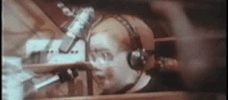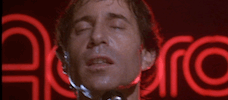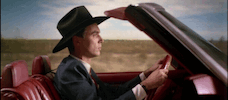Reviews
Bob Dylan
USA, 1978
Credits
Review by Tyler Wilcox
Posted on 13 December 2010
Source Bootleg DVD
External links
Related music at Doom & Gloom from the Tomb
Categories Rock Follies
“About a third is improvised, about a third is determined, and about a third is blind luck,” Bob Dylan told an interviewer in 1978.1 He was referring to his much-maligned, rarely seen four-hour opus Renaldo & Clara, released theatrically ever so briefly that year, but the quote could easily be applied to Dylan’s career as a whole. The singer-songwriter has relied on a blend of devil-may-care attitude, genuine artistic brilliance and simple twists of fate to create some of the most fascinating music of the past 50 years. But the strategy, when applied to filmmaking, has mostly misfired.
Perhaps not coincidentally, the most successful cinematic representation of Dylan is a film that the songwriter did not have creative control over. Don’t Look Back, D.A. Pennebaker’s documentary of Dylan’s 1965 UK tour, captures the then-solo acoustic troubadour poised on the precipice of rock superstardom and almost unheard of cultural currency. But beyond the historic aspects of Pennebaker’s film, Don’t Look Back works surprisingly well as a compelling drama. Using real life situations and people (with the charismatic Dylan center stage), the filmmaker constructs a narrative that feels as cohesive and complete as any great fictional work. Don’t Look Back isn’t just one of the best movies about music in the 1960s, it’s one of the best movies of the 1960s.
Dylan, however, disliked Pennebaker’s film. He grudgingly hired the documentarian again for his candle-burning-at-both-ends 1966 European tour with the Hawks (later to be known as The Band), but rejected the rough edit Pennebaker subsequently delivered. Working in tandem with cameraman/editor Howard Alk, Dylan then used Pennebaker’s footage to make Eat The Document, a disjointed, hallucinatory anti-documentary that - despite some gripping live performances - is mostly an incomprehensible mess. If Don’t Look Back made the audience the proverbial fly on Dylan’s wall, Eat The Document sends that same fly buzzing madly through Dylan’s amphetamine riddled psyche.2
All of which brings us to Renaldo & Clara, made a decade later, again in collaboration with Howard Alk and again using raw tour footage to illustrate the shadowy recesses of Dylan’s mind. The tour in question this time was the Rolling Thunder Revue of late 1975, which saw Dylan taking a motley crew of musicians (including Roger McGuinn, Ronee Blakely, Joan Baez, Ramblin’ Jack Elliott, Bob Neuwirth, T-Bone Burnet, and Joni Mitchell) on a trip through the northeastern United States and Canada. Much of the non-musical documentary material in Renaldo & Clara is devoted to demystifying the rock tour experience, using techniques that anticipate (and perhaps influenced) later films like Radiohead’s Meeting People Is Easy and Wilco’s I Am Trying to Break Your Heart: the audience is treated to long sequences of roadies setting up equipment in empty arenas, awkward media meet ‘n’ greets, stoned rap sessions with fans and groupies, and interminably long train and car rides. It’s all pretty boring - which is probably the point.
Thankfully, though, these dull moments are sharply contrasted by the performance footage. As evidenced by the two-CD set Live 1975 (released in 2002) and various bootlegs, the tour was hugely successful on a musical level, with Dylan playing an inspired batch of new songs (later to turn up in somewhat inferior forms on Desire), along with reinvented, impassioned versions of older tunes. Thus we get Dylan and his band in full flight, tearing through “A Hard Rain’s A-Gonna Fall” (re-imagined as a smoking electric blues number), a fierce “Isis,” and a biting “It Ain’t Me, Babe.” Dylan, normally a reserved performer, appears positively possessed in these clips, gesticulating wildly (often sans guitar) and snapping out lyrics with an authority unseen since the glory days of 1966. The band is fascinating as well, blending the glammy guitar of Mick Ronson (better known as one David Bowie’s Spiders from Mars) with the gypsy violin of Scarlet Riviera and country-fried licks of multi-instrumentalist David Mansfield.
If Dylan had released a straightforward visual showcase of this band, we might be speaking of Renaldo & Clara as one of the great concert films of the rock era. Alas, the elements described above take up just about an hour of Renaldo & Clara’s running time - the film isn’t called The Rolling Thunder Revue, after all. No, much of Renaldo & Clara is devoted to semi-improvised dramatic scenes that suggest an unholy collaboration between Sam Peckinpah and John Cassavetes. (That description that might whet the appetites of cinephiles, but trust me, it’s nowhere near that good.) These barely-written, clumsily edited scenes, mainly featuring Dylan’s then-wife Sara, playwright/actor Sam Shepard, Joan Baez and Dylan himself, are made of the flimsiest of materials, and it shows. The actors (or, in most cases, non-actors) don’t seem to have been given much in the way of guidance, and they painfully grope for something, anything, that might lead to a meaningful exchange. “I need you,” Shepard tells Sara Dylan at one point. “Need me for what?” she asks. “I need you to perform certain magical things with me, that’s all,” Shepard responds. It’s a fairly typical moment.
The “plot” at hand appears to involve some kind of love quadrangle between the four principals - with Harry Dean Stanton poking up here and there - but it would take a hardier Dylanologist than I to sort through the oblique mixture of autobiography, fantasy and symbolism present here.3 It’s clear that Dylan had only the vaguest notions of what Renaldo & Clara would be during shooting, and pasted the film together during the editing process. Not necessarily a terrible way to make a movie, but one wishes it didn’t feel like such a slog.
How to approach Renaldo & Clara, then? Mostly, I didn’t attempt to analyze the film to any great degree; I just tried to soak in the singularly strange atmosphere. And what could be stranger than Dylan selling Baez to Dean Stanton for a horse? Or Allen Ginsberg attempting to woo a trio of hookers with a poem? There is one particularly good, brief scene between Dylan and Baez, displaying a chemistry between the pair that never quite comes across in their onstage duets. But like I said, it’s brief.
Perhaps most frustrating is Dylan himself, who, aside from the performance footage, remains on the fringes of the film. When he does appear - as Renaldo, the end credits tell us - he’s an almost laughably limp presence. If anyone asks him a question, he responds, “I don’t know,” or “You tell me,” or simply with a stony silence. The passive nature of his character is curious, considering his auteur status behind the camera. Maybe Dylan knew that every moment of the film would be infused with his powerful persona, regardless of whether he dominated the screen. Maybe he’s just not a very good actor.
The critics pounced on Renaldo & Clara, but Dylan himself may have realized the fundamental shortcomings of his cinematic creation. Shortly after the film was released, he pulled it from distribution and allowed only a handful of subsequent screenings on European television in the 1980s. It remains unavailable on DVD (or any other format) to this day. His next stab at cinema, Masked & Anonymous, wouldn’t arrive for another two decades. But that’s a Rock Folly for another day.
- “Bob Dylan: The Rolling Stone Interview,” by Jonathan Cott, Rolling Stone, Jan. 26, 1978. ↩
- Though Pennebaker’s edit of the 1966 tour footage, Something Is Happening Here, remains unseen, a more linear depiction of this period utilizing his footage can be seen in Martin Scorsese’s No Direction Home documentary from 2005. ↩
- And I consider myself to be a pretty hardy Dylanologist! ↩
More Rock Follies
-

Head
1968 -

Sympathy for the Devil
1968 -

Alice’s Restaurant
1969 -

200 Motels
1971 -

Journey Through the Past
1972 -

Human Highway
1982 -

Renaldo and Clara
1978 -

One Trick Pony
1980 -

Give My Regards to Broad Street
1984 -

The Man Who Fell to Earth
1976 -

True Stories
1986
We don’t do comments anymore, but you may contact us here or find us on Twitter or Facebook.



